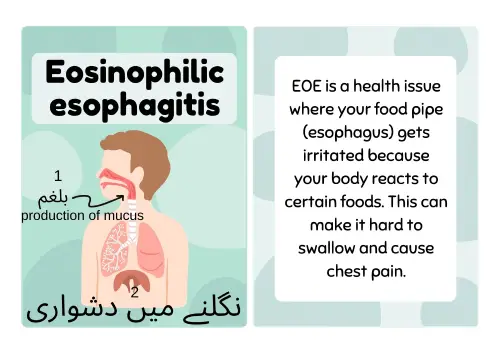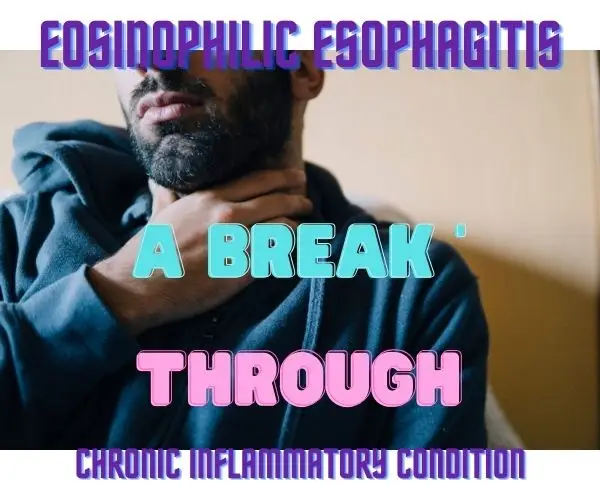A Comprehensive Overview of the Condition and Recent Treatment Advances with 1st oral API
Eosinophilic esophagitis EoE :
Eosinophilic esophagitis or EoE is a chronic inflammatory disorder of the esophagus characterized by the presence of an elevated number of eosinophils, a type of white blood cell, in the esophageal tissue. This condition has gained increasing recognition in recent years, with advancements in understanding its pathogenesis and the development of novel treatment options to address its debilitating symptoms.
Overview of Eosinophilic Esophagitis:

EoE is considered to be a part of the broader spectrum of eosinophilic gastrointestinal disorders (EGIDs), which also includes eosinophilic gastritis, gastroenteritis, and colitis. While the exact cause of EoE is not fully understood, it is believed to involve a complex interplay of genetic predisposition, environmental factors, and immune dysregulation.
Individuals with EoE often present with symptoms such as difficulty swallowing (dysphagia), food impaction, chest pain, heartburn, and nausea. These symptoms can significantly impair a person’s quality of life and may lead to complications such as esophageal strictures or narrowing if left untreated.
Classic Treatment Approaches:
Historically, the management of EoE has centered around symptom control and reduction of esophageal inflammation. Common treatment approaches have included:
- Dietary Modification: Identifying and eliminating trigger foods from the diet, often through an elimination diet guided by an allergist or gastroenterologist.
- Medication: The use of medications such as proton pump inhibitors (PPIs) to reduce gastric acid production and corticosteroids (topical or systemic) to suppress inflammation in the esophagus.
- Procedural Interventions: Esophageal dilation may be necessary in cases where strictures have developed, causing difficulty swallowing.
While these approaches have been effective for some individuals, there has been a need for more targeted and efficacious treatments specifically designed for EoE.
New Treatment Option Approved by the FDA:
In a significant milestone for the EoE community, the United States Food and Drug Administration (FDA) recently approved budesonide oral suspension for the treatment of EoE. Marketed under the brand name Eohilia, this oral medication represents the first FDA-approved treatment specifically indicated for Eosinophilic esophagitis.
Budesonide oral suspension is a corticosteroid formulation designed to address esophageal inflammation and alleviate symptoms of dysphagia associated with EoE. It is available in single-dose stick packs containing 2 mg/10 mL of the active ingredient budesonide.
FDA approved Budesonide Oral Suspension
The formulation of budesonide oral suspension in Eohilia is notable for its unique thixotropic properties. This means that the medication flows more freely when shaken, facilitating ease of administration, and returns to a more viscous state when swallowed, ensuring optimal delivery to the esophageal tissue.
Clinical trials supporting the FDA approval of budesonide oral suspension demonstrated its efficacy in achieving histologic remission and improving dysphagia symptoms in patients with Eosinophilic esophagitis. Compared to placebo, a significantly higher proportion of patients treated with budesonide oral suspension experienced remission of esophageal inflammation and reported improvements in dysphagia.
Safety Profile and Adverse Reactions:
As with any medication, budesonide oral suspension is associated with potential side effects. Common adverse reactions observed in clinical trials included respiratory tract infection, gastrointestinal mucosal candidiasis, headache, gastroenteritis, throat irritation, adrenal suppression, and erosive esophagitis. It is essential for healthcare providers and patients to weigh the benefits and risks of treatment and closely monitor for any adverse events.
Bottom line
Eosinophilic esophagitis is a condition where inflammation and swelling in the esophagus cause narrowing, making it hard for food to pass smoothly during swallowing. This leads to symptoms like difficulty swallowing (dysphagia), food getting stuck, and discomfort or pain while eating. Recently, the FDA approved a breakthrough treatment called budesonide, marketed under the brand name Eohilia, which helps alleviate symptoms and improve the quality of life for individuals with EoE.
| eosinophilic esophagitis |

